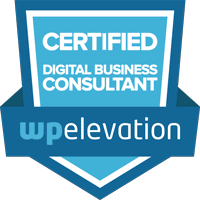If we had a pound for every time we’d heard the question ‘How much does a website cost?’, we could probably afford to stop designing and building websites.
Although then we’d have a lot of free time to spend. Which would end up spent on the internet. Where we’d see poorly designed websites and wish we’d had the chance to do a better job. Sounds terrible. So, we’ll stick to answering the question instead.
And the only fair answer to ‘How much does a website cost?’ is ‘It depends’.
Imagine, for a moment, that you’re a car salesperson. It’s a Saturday. The showroom is quiet. Then the door opens and in walks a would-be customer. Exciting. They approach your desk.
“Hi!” says the customer. “How much is a car?”
How do you reply to that? The safe money says you’re going to ask, “What sort of car are you thinking of?”. Depending on the answer you get, you’re going to ask some other questions.
Park that for a moment. Now imagine you’re an estate agent. For some variety, let’s say it’s Sunday. You can see a pair of heads bobbing about outside, beyond the property display posters in the window.
The door opens and in comes a couple, hand in hand.
“Hi!” says one “We’re looking to buy a new place to live. How much will it cost?”
You don’t have a single figure to give them, do you? Because it depends…
How much a website costs depends – first and foremost – on what you need it to do for you
And that cost can range from next to nothing, up to enough to buy the most expensive car in the showroom or a studio flat through the estate agent.
We categorise websites as falling into one of four types and one of four price brackets:
- Self-build website: From free to £25 a month
- Small, templated website: £500 – £1,500
- Custom-designed website: £2,500 – £8,000+
- Large/complicated website: £10,000 – £50,000+
The self-build website
We’ve written before about choosing between a self-build website and hiring a web designer. A self-build website, provided by the likes of Wix and Squarespace is a great starter website if you’re a sole trader and you’re starting from nothing.
You’d need a lot of time, of course, to choose from the free or cheap templates, and to figure out the proprietary drag-and-drop website builder and create and upload all your content. There are definite limits to design and functionality, analytics and search engine optimisation (SEO) and the guidance you’ll get to show you right from wrong is minimal. But if you’ve more time than money, a little design nous and you buy your own domain name, a self-build website is a good starting point.
The small, templated website build
These are typically built on a content management system (CMS) like WordPress or the less well-known Joomla or Drupal. You’ll choose a pre-designed template – either free or, if you want a bit more flexibility – for a one-off fee.
These generally look more professional than a self-build site, but they can still be rather restrictive. The WordPress dashboard is fairly intuitive, but you’ll probably want to spend some time in online tutorials to be sure you know what you’re doing. It’s remarkably easy to break a website just by updating a plug-in. And there are plug-ins aplenty.
You’ll do a lot of trial-and-error testing for different functions provided by various tools and you may find there are things you can’t do – even tiny design details – without changing the code. WordPress allows you to do this, but it’s wise to leave code changes to the pros. Otherwise, you’re on your own. It’s a question of how much your time is worth and whether spending that time building the business – rather than building a website which may involve some compromises – actually makes good economic sense.
On the other hand, you can employ a freelance web designer to build you a website on WordPress or similar CMS. The difference in this price bracket is that the designer will probably be using and tweaking pre-designed templates. There will still be limitations in design options and functionality, although their expertise should mean those limitations are less restrictive. The more deviation from a standard template design you want, the more you should expect to pay.
The custom-designed website build
Designed for you, for your business, for your business strategy. What you both want and need, really. This is the level at which a website becomes a business development tool, not just a simple portfolio or brochure site.
Just as importantly, a custom-designed website should give you an expert to manage the whole website design and build process. At the lower end of the price bracket for a custom website, you’ll probably still be expected to outline your business strategy, as well as the website content – words, pictures, videos.
The best websites happen when the web design agency truly understands your business strategy. It’s actually helpful to workshop this, even if you have a clear idea of where you want your business to be in five years’ time, if only to give the web company deep insights into the journey.
With a custom site, you’re paying for expertise as well as the design and build. You should get guidance from start to finish. A discovery phase will look at your business model, identify the shortcomings with your existing website, explore your target audience and your competitors. If you have already mapped out the road ahead for your business, it will inform the discussions about functionality and scalability; if you haven’t, a good web development company will know how to help you align your aspirations with a good web strategy. They’ll offer advice and input on SEO, pay-per-click and other targeted advertising techniques, and they’ll be able to introduce copywriters and photographers they trust.
They’ll train you in using the backend of the CMS, so that you can do your own updates without fear of breaking anything – and they’ll be on hand if you manage to break it nonetheless. They’ll also only work with plug-ins and components they know and trust, so that your site is always up to date, functioning and secure.
The large/complicated website build
The highest price bracket is for custom-built websites that contain a great quantity or variety of content and products and usually some very advanced and flexible functionality. The steeper price tag will reflect not just the complexity and time of the design and build, but the team of people needed to develop and maintain the site.
Site built, job done?
Only if you want the money you’ve spent so far to be a poor investment. Because that’s what this is: an investment in your business. Getting a good return on that investment depends on two things: marketing and promoting your website; and maintaining the site behind the scenes, to be sure it’s always performing well and always secure.
Writing new, engaging content in the form of articles, blog posts, white papers and suchlike, and running well-targeted advertising campaigns on Google or Facebook, for instance, can deliver major SEO advantages and help you move up the search results. Whether it’s your time and expertise, or you hire it in, there’s a cost to consider.
Maintenance and technical support are a vital investment for anything more than a very simple website. Software gets updated frequently, compatibility between software can change, new online threats emerge frequently; a good support and maintenance contract – typically starting from around £50 a month – will protect your initial investment, your data and your customers, and ensure you’re always open for business.
How much does Fifteen Three Digital charge?
We specialise in the custom-designed website category. We design, build and maintain bespoke websites for businesses looking for a better web presence that will support their long-term plans.
Most of our clients already have a website – and it may not even be their first website – but, for some reason, it’s not quite delivering the business boost they’d hoped for.
It’s not just our technical or design know-how that gets results. That vital stuff only works if your web development company has asked all the right questions in the first place. Who are your customers? Why do they choose you over a competitor? Who are your competitors? What’s the buying journey? What do you want a new website to do for you and for your customers – what should it achieve? What other marketing activities – online and offline – do you use? What percentage of your business comes through your existing website as the first point of contact? What do you want to your business to be that it isn’t already?
Your answers to all of those questions help inform the website strategy we’ll plan out for you. Specifying the precise functionality and content comes later – this is your website roadmap for the next few years.
Your investment is likely to be in the £2.5k – £7k bracket, depending on the number of pages you need, the extent and variety of functionality, and how many different page designs you need.
Just like a car or a house, how much your website costs depends… on your answers to all those questions and more.
Taking the first step towards your new website
If you’re just starting out or a website is pretty much going to be a fixed brochure for years ahead, look for the best-value – but best quality – self-build or templated website you can afford.
Really take the time to think about what you want your website to do for you, and where you want your business to be in a few years’ time. Saving money or cutting corners in the early days could prove to be a false economy if you’re having to start over in 6-12 months’ time. If you talk to a web design company, do mention the nice-to-have features, or the features you might not need to include for a year or so – knowing that they’re on the horizon should ensure the website build will support them when you’re ready.
Don’t be rushed. Don’t be pressured. Choose a company which you believe wants to achieve your goals as much as you do. This is an investment and you want a good return on it. Don’t be afraid to ask questions; the right developer knows the value in good research.
And if you’re looking for a bespoke website, we’d love to see if we can help.


